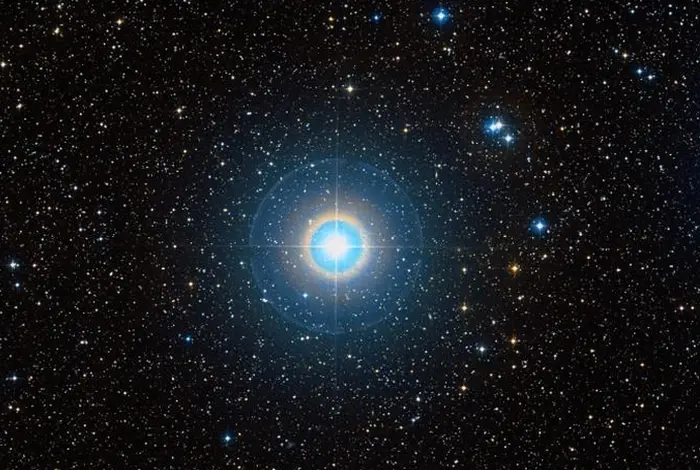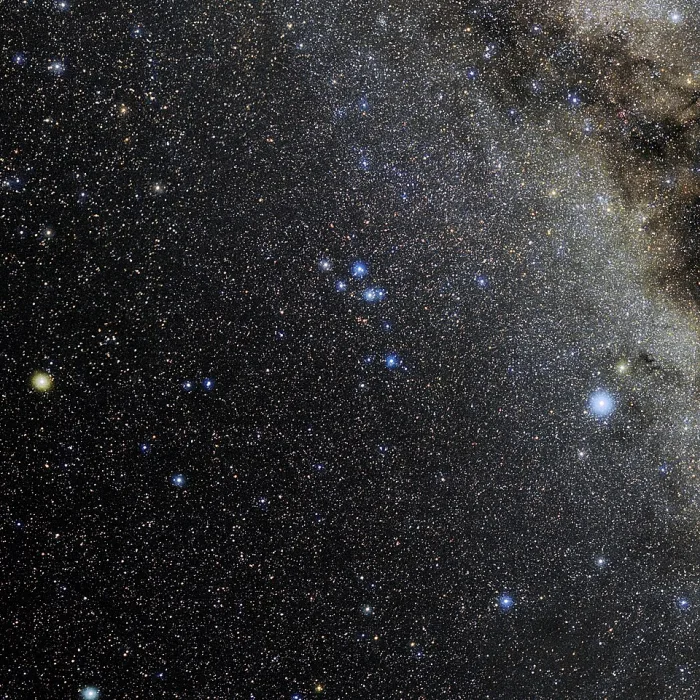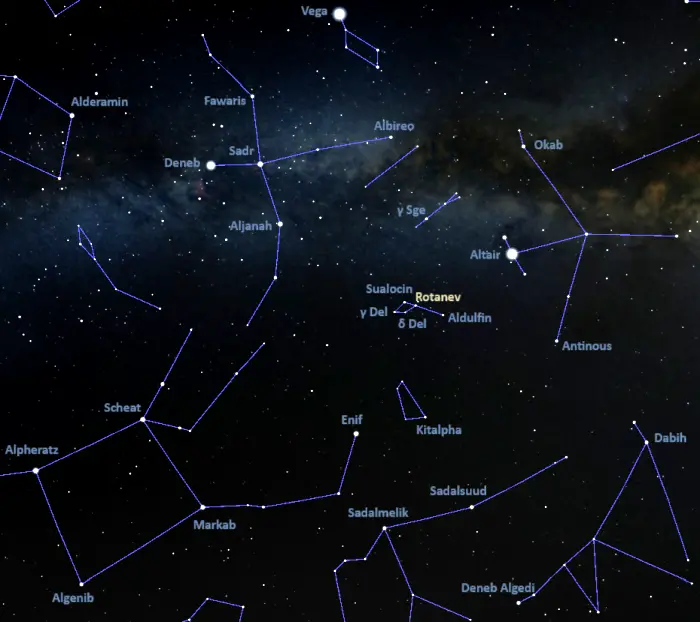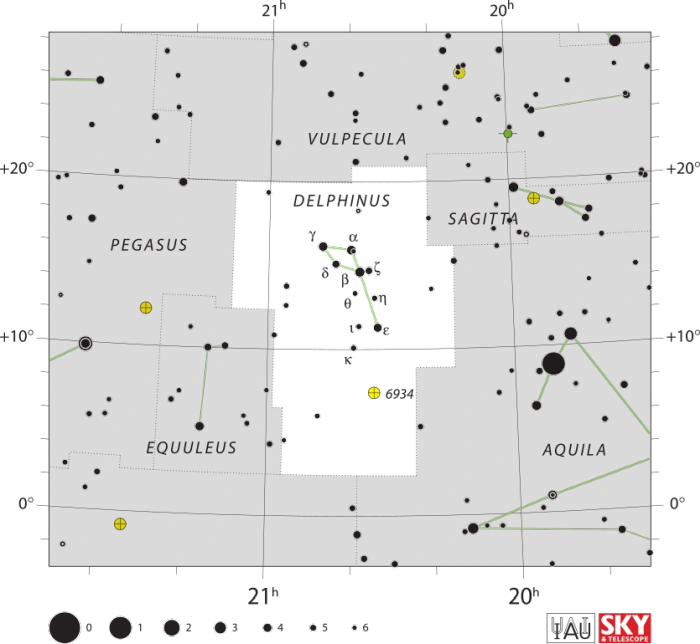Rotanev, Beta Delphini (β Del), is a binary star system located 101 light years away in the constellation Delphinus. With an apparent magnitude of 3.617, it is the brightest point of light in the constellation. It forms a star pattern known as Job’s Coffin with the fainter Sualocin (Alpha Delphini), Gamma and Delta Delphini.
Star system
Beta Delphini is a binary star composed of a yellow-white giant of the spectral type F5 III and a yellow-white subgiant with the stellar class F5 IV. The two stars orbit each other with a period of 26.660 and an eccentricity of 0.36. They are separated by only 0.440 arcseconds in the sky.
The larger primary component, Beta Delphini A, has a mass of around 1.75 solar masses. With a surface temperature of 6,587 K, it is 24 times more luminous than the Sun. It spins with a projected rotational velocity of 49.8 km/s. The star is much younger than the Sun. It has an estimated age of 1.79 billion years.
The smaller companion, Beta Delphini B, has 1.47 times the Sun’s mass and shines with 8 solar luminosities.
Individually, Beta Delphini A and B shine at magnitudes 4.11 and 5.01.

Rotanev (Beta Delphini), image credit: ESO/Digitized Sky Survey 2 (CC BY 4.0)
Facts
Rotanev forms an asterism called Job’s Coffin with Sualocin (Alpha Delphini), Gamma Delphini and Delta Delphini. The diamond-shaped asterism corresponds to the body of the Dolphin. Aldulfin (Epsilon Delphin), the star that marks the Dolphin’s tail, completes the constellation figure of Delphinus.
In traditional Chinese astronomy, Rotanev formed an asterism known as Good Gourd (瓠瓜, Hù Guā) with Sualocin, Gamma2 Delphini, Delta Delphini, and Zeta Delphini. The asterism was part of the larger Girl mansion, one of the northern mansions of the Black Tortoise.
The binary nature of Beta Delphini was discovered by the American astronomer Sherburne Wesley Burnham in 1873. Burnham catalogued the system as BU 151AB.

Photo of the constellation Delphinus produced by NOIRLab in collaboration with Eckhard Slawik, a German astrophotographer. Image credit: E. Slawik/NOIRLab/NSF/AURA/M. Zamani (CC BY 4.0)
Name
The name Rotanev (pronunciation: /ˈroʊtənɛv/) comes from Italian astronomer Giuseppe Piazzi’s Palermo Star Catalogue of 1814. It is Venator written in reverse. Nicolaus Venator (Nicholas Hunter) is the Latinized name of Niccolò Cacciatore, Piazzi’s assistant and later director of the Palermo Observatory. The name of Alpha Delphini, Sualocin, is Nicolaus in reverse. Both names first appeared in the Palermo catalogue.
American astronomer Elijah Hinsdale Burritt listed the two stars as Rotanen and Scalovin in his Atlas of 1856.
The origin of the names Rotanev and Sualocin was a mystery for several decades, until the British astronomer Reverend Thomas Webb worked out the solution. In his 1859 book Celestial Objects for Common Telescopes, Webb wrote:
“Where so eminent and accomplished a scholar and antiquarian has not succeeded, it would seem presumptuous to offer a solution, but that accident is sometimes more fortunate than study; and if the following is not after all the right key, it certainly is a marvel that it should open the lock so readily. The letters of these strange words, reversed, form NICOLAUS VENATOR, in which it is easy to recognize a Latin version of the name of NICCOLO CACCIATORE, assistant at the Palermo Observatory, in the Catalogue emanating from which these stars are so denominated.”
The International Astronomical Union’s (IAU) Working Group on Star Names (WGSN) approved the name Rotanev for Beta Delphini on September 12, 2016. The name formally applies only to the primary component, Beta Delphini A, but has been informally used for the whole star system.
Location
Rotanev is easy to find on a clear, dark night because it is part of the distinctive constellation figure of Delphinus. It is the star at the base of the Dolphin’s tail. The recognizable star pattern of the Dolphin appears just outside the Summer Triangle, formed by Deneb in the constellation Cygnus (the Swan), Vega in Lyra (the Harp), and Altair in Aquila (the Eagle). It can be seen about a third of the way from Altair in Aquila to the Great Square of Pegasus in Pegasus and Andromeda.
At declination +14° 36′, Rotanev is visible from virtually any location on Earth that is not too heavily light polluted.

Rotanev location, image: Stellarium
Constellation
Rotanev is located in the constellation of Delphinus. The celestial Dolphin was one of the Greek constellations listed by the astronomer Claudius Ptolemy of Alexandria in his Almagest in the 2nd century CE. In Greek mythology, it is associated with Poseidon’s messenger Delphinus, who persuaded the Nereid Amphitrite to marry the sea god. The constellation is also linked with the dolphin that saved the Greek poet and musician Arion at sea and carried him to safety.
Delphinus lies just north of the celestial equator between the brighter Aquila (the Eagle) and Pegasus (the Winged Horse). Occupying an area of only 189 square degrees, it is the 69th largest of the 88 constellations.
Notable stars in Delphinus include the evolved blue subgiant star Sualocin (Alpha Delphini), the hot blue giant Aldulfin (Epsilon Delphini), the binary systems Gamma Delphini and Kappa Delphini, the variable star Delta Delphini, the white main sequence stars Zeta Delphini and Rho Aquilae, the yellow giant Musica (18 Delphini), the K-type giant 17 Delphini, the K-type supergiant Theta Delphini, and the white subgiants Eta Delphini and Iota Delphini.
The constellation is also home to the classical nova V339 Delphini (Nova Delphini 2013) and the yellow symbiotic star He 2-467.
Delphinus hosts several notable deep sky objects. These include the planetary nebulae NGC 6891 and the Blue Flash Nebula (NGC 6905), the spiral galaxies NGC 7003, NGC 6956 and NGC 7025, and the globular clusters NGC 6934 (Caldwell 47) and NGC 7006 (Caldwell 42).

Delphinus constellation map by IAU and Sky&Telescope magazine (Roger Sinnott & Rick Fienberg) (CC BY 3.0)
The best time of the year to observe the stars and deep sky objects in Delphinus is during the month of September, when the constellation climbs high above the horizon around 9 pm. The entire constellation can be seen from locations north of the latitude 69° N.
The 10 brightest stars in Delphinus are Rotanev (Beta Del, mag. 3.617), Sualocin (Alpha Delphini, mag. 3.777), Aldulfin (Epsilon Delphini, mag. 4.03), Gamma Delphini (mag. 4.360), Delta Delphini (mag. 4.43), Zeta Delphini (mag. 4.647), Rho Aquilae (mag. 4.94), Kappa Delphini (mag. 5.05), 17 Delphini (mag. 5.18), and Eta Delphini (mag. 5.38).
Rotanev – Beta Delphini
| Spectral class | F5 III + F5 IV |
| Apparent magnitude | 3.617 ± 0.016 (4.11 + 5.01) |
| Distance | 101 ± 1 light years (30.9 ± 0.4 parsecs) |
| Constellation | Delphinus |
| Right ascension | 20h 37m 32.94130s |
| Declination | +14° 35′ 42.3195″ |
| Names and designations | Rotanev, Venator, Rotanen, Beta Delphini, Beta Del, β Delphini, β Del, 6 Delphini, 6 Del, HD 196524, HR 7882, HIP 101769, SAO 106316, BD+14 4369, SKY# 39052, PLX 4906.00, JP11 3257, GC 28709, GCRV 12902, IRC +10473, Renson 54790, CSI+14 4369 1, CSI+14 4369 5, CSI+14 4369 6, BU 151, GEN# +1.00196524, GSC 01100-01720, N30 4554, ROT 3004, 2E 4395, 2E 2035.2+1425, TD1 27036, SBC7 821, SBC9 1248, AKARI-IRC-V1 J2037329+143542, 1RXS J203732.7+143537, UBV 17888, UBV M 25011, uvby98 100196524, TIC 456645647, WEB 18382, YZ 14 8041, TYC 1100-1720-1, IRAS 20352+1425, 2MASS J20373291+1435421, Gaia DR2 1810448909926616448, Gaia DR3 1810448909928688768, ADS 14073 AB, CCDM J20375+1436AB, IDS 20328+1415 AB, WDS 20375+1436AB |
Beta Delphini A
| B – V colour index | 0.43 ± 0.14 |
| Proper motion | RA: +118.09 ± 0.47 mas/yr |
| Dec.: -48.06 ± 0.43 mas/yr | |
| Parallax | 32.33 ± 0.47 mas |
| Absolute magnitude | 1.58 ± 0.12 |
| Mass | 1.75 ± 0.002 M☉ |
| Luminosity | 24 L☉ |
| Temperature | 6,587 K |
| Metallicity | -0.05 dex |
| Age | 1.79 billion years (1.07 – 1.96 billion years) |
| Rotational velocity | 49.8 km/s |
| Surface gravity | 3.50 cgs |
Beta Delphini B
| B – V colour index | 0.56 ± 0.25 |
| Absolute magnitude | 2.79 ± 0.14 |
| Mass | 1.47 ± 0.04 M☉ |
| Luminosity | 8 L☉ |